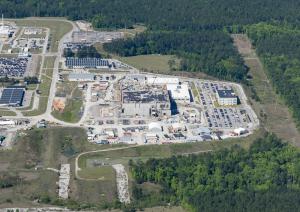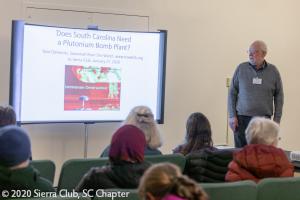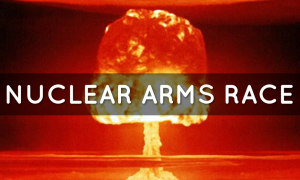DOE Aims at $4.6 Billion to Convert Ill-Constructed MOX Plant into Plutonium Bomb Plant (PBP) at Savannah River Site

DOE Plans for Plutonium Bomb Plant (PBP) in Terminated Plutonium Fuel (MOX) Buiding at Savannah River Site. $8 billion was wasted on MOX and congressional investigations needed. Photo used with permission, courtesy of High Flyer
As U.S. DOE Prepares for New Nuclear Arms Race, $442 Million Request in Fiscal Year 2021 for Plutonium Bomb Plant at SRS - Revealed in Feb 26 NNSA Budget Volume
COLUMBIA, SOUTH CAROLINA, US, February 27, 2020 /EINPresswire.com/ -- A budget document released by the U.S. Department of Energy late on Wednesday, February 26 reveals that the agency has assumed a stunning projected cost of $4.6 billion to convert the poorly constructed plutonium fuel (MOX) building at the Savannah River Site - near Aiken, SC - into a Plutonium Bomb Plant (PBP). This amount of spending reveals that DOE and contractors aim to repurpose the failed MOX project into a perpetual money machine, according to the public interest group Savannah River Site Watch (https://srswatch.org/).
The budget document, the National Nuclear Security Administration’s funding request to Congress for Fiscal Year 2021, confirms that the agency is seeking $441 million for “repurposing” the MOX building into the unjustified Plutonium Bomb Plant. The massive amounts of requested or anticipated funds reveal that the MOX plant is in poor shape and internal components, such as piping and HVAC systems, will have to be ripped out and much construction reworked. (Link to most recent MOX photos posted here.)
“Plans to throw vast sums of our money at an unjustified, rushed Plutonium Bomb Plant, central to a new nuclear arms race, is a DOE formula for failure and, like the mismanaged MOX project, is guaranteed to run far over budget and fall far behind schedule,” according to Tom Clements, director of SRS Watch. “Sadly, it is no surprise that the failed MOX project, on which $8 billion was wasted, is turning into a money machine for private contractors who aim to feed off creation of a Plutonium Bomb Plant at SRS,” added Clements. The Plutonium Bomb Plant would make plutonium “pits” (or triggers, which cause the nuclear explosion) for thousands of nuclear new and refurbished nuclear weapons, all part of a new plan to engage in a dangerous and costly new nuclear arms race.
The overall DOE budget request reveals a massive increase in nuclear weapons activities. The NNSA request is up 18.4% from Fiscal Year 2020, to $19.8 billion. The Weapons Activities’ budget request is $15.6 billion, up 25.2 percent above the FY 2020 enacted amount, according to a NNSA news release of February 10, the day top-line items of the budget were released. Meanwhile, the DOE site clean-up budget absorbs the brunt of the increase in pit production, from about $7.5 billion appropriated in FY20 to a FY 21 request of $6.1 billion. “The huge decrease in clean-up funding and exploding increase in nuclear weapons reflects reversed, unjustifiable budget priorities,” according to Clements.
The NNSA budget request (on page 199) reveals the stunning sums of money it seeks to make 50 or more plutonium pits per year at SRS by 2030, a site that has had zero experience in handling pits, zero experience in casting liquid plutonium and little experience in processing plutonium since all five production reactors ceased operation in the late 1980s:
"This project was initiated in FY 2019 utilizing Other Project Costs (OPC) funding in the Plutonium Sustainment Program. Critical Decision (CD) 0, Approve Mission Need, for the “Plutonium Modular Approach” was approved on November 25, 2015 with a preliminary Total Project Cost (TPC) range of $1.3B to $3.0B with a project completion schedule range of December 2025 to December 2027. The most recent cost and schedule estimates were developed during the Plutonium Pit Production Engineering Assessment (EA) in 2018 with an estimated construction high end of the cost range at $4.59B and a CD-4 schedule range of July 2026 to January 2030. … The Mission Need Statement was revised in March 2019 for the now titled “Savannah River Plutonium Processing Facility (SRPPF)”."
"The FY 2021 Request for Savannah River Plutonium Modernization and Pit Production is $441,896,000 which includes $241,896,000 for construction design, $110,000,000 for Other Project Costs (OPC) funding in the Savannah River Plutonium Operations Program for the planned project, Savannah River Plutonium Processing Facility, and $90,000,000 for Plutonium Modernization work to support the capability to produce 50 pits per year at Savannah River."
As it rushes headlong with plans for pit production at SRS, NNSA is also planning on a massive spending increases at the Los Alamos National Laboratory in New Mexico to make 30 or more pits per year by 2026. The pit-related request for Los Alamos in Fiscal Year 2021 is a stunning $884,599,000.
NNSA is refusing to review reuse of over 15,000 pits stored at DOE’s Pantex site in Texas and has so far refused to take another serious look at pit lifetime. A 2007 study entitled “Pit Lifetime” - https://fas.org/irp/agency/dod/jason/pit.pdf - by the JASON group for NNSA, said that most pit types “have credible minimum lifetimes in excess of 100 years as regards aging of plutonium.”
SRS Watch, along with fellow members of the Alliance for Nuclear Account Ability (ANA) - Nuclear Watch New Mexico and Tri-Valley CAREs - are reviewing legal options given NNSA’s failure to prepare the mandated Programmatic Environmental Impact Statement (PEIS) to review system-wide impacts of pit production. Underscoring the need for the PEIS, the current DOE budget request reveals that a host of sites beyond SRS and Los Alamos are involved in pit activities. An analysis of NNSA’s budget request by Nuclear Watch New Mexico reveals that NNSA “has requested $1.58 billion for expanded plutonium pit production in FY 2021 alone.”
###
Notes:
See DOE FY 21 budget request for NNSA - volume 1 - posted late afternoon, Feb 26, 2020:
https://www.energy.gov/cfo/downloads/fy-2021-budget-justification
https://www.energy.gov/sites/prod/files/2020/02/f72/doe-fy2021-budget-volume-1.pdf
NNSA news release on budget request, February 10, 2020:
https://www.energy.gov/nnsa/articles/fy-2021-presidential-budget-nnsa-released
NNSA’s 293-page ‘Pu Pit Production Engineering Assessment” is available at:
https://nukewatch.org/importantdocs/resources/Pu-Pit-Engineering-Assessment-Report-Rev-2_20-April-2018.pdf
"NNSA should focus on cleanup," by Ralph Hutchison, coordinator of the Oak Ridge Environmental Peace Alliance (OREPA) - a member of the Alliance for Nuclear Accountability - in Oak Ridger newspaper, Feb. 26, 2020:
https://www.oakridger.com/news/20200226/guest-column-nnsa-should-focus-on-cleanup
Thomas Clements
Savannah River Site Watch
+1 803-834-3084
email us here
Visit us on social media:
Facebook
Twitter
Legal Disclaimer:
EIN Presswire provides this news content "as is" without warranty of any kind. We do not accept any responsibility or liability for the accuracy, content, images, videos, licenses, completeness, legality, or reliability of the information contained in this article. If you have any complaints or copyright issues related to this article, kindly contact the author above.


